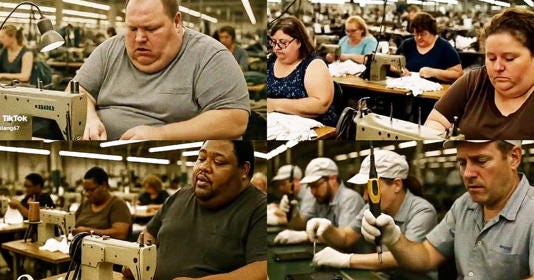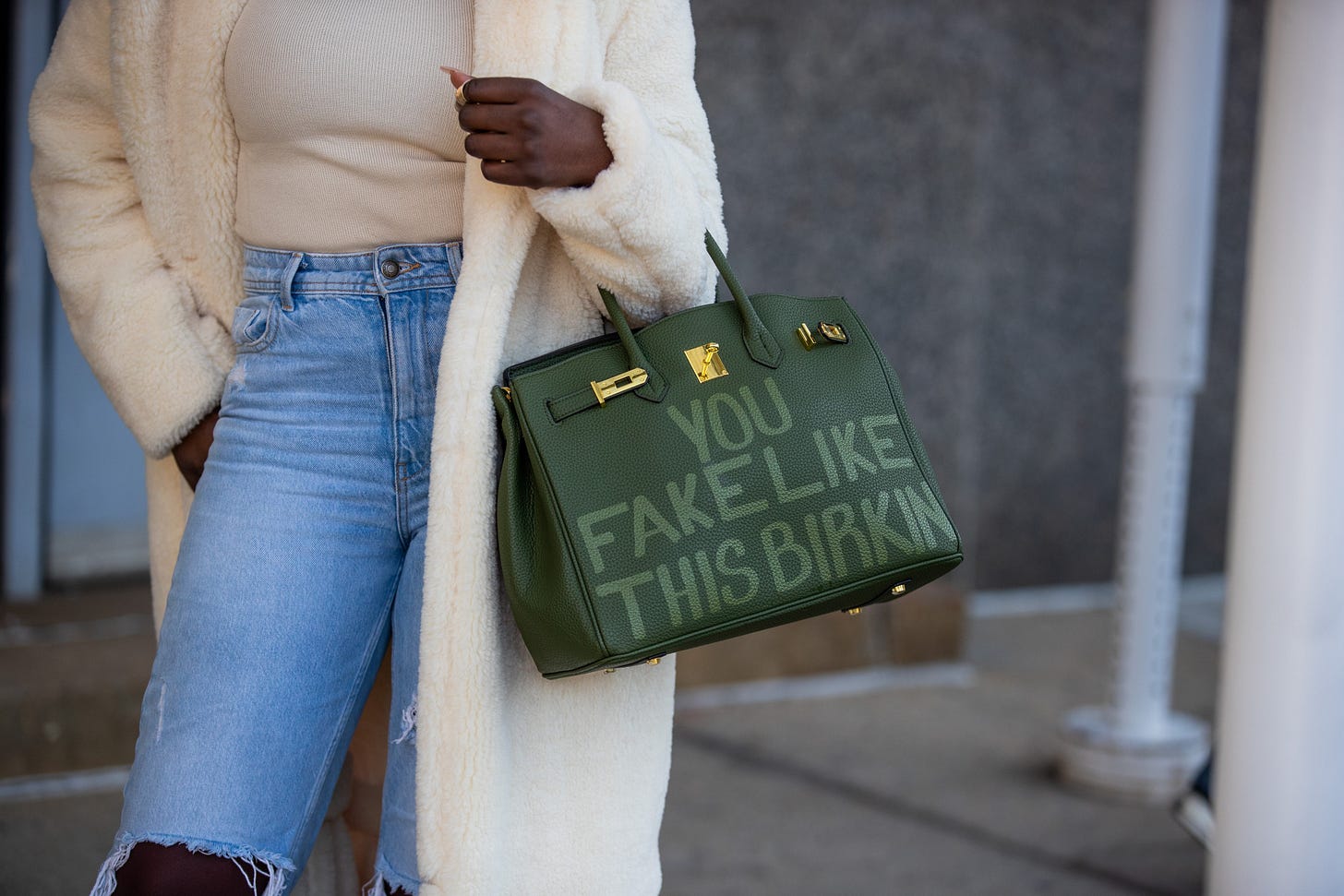"No Gatekeeping..." #13
The invisible systems suddenly made visible...and memeable
APR 14, 2024
The hidden economics behind your sneakers and how tariffs shape what you pay
How Chinese manufacturers are pulling back the curtain on luxury brands' "Made in America" claims
The surprising complexity of tariffs – from medical supplies to children's books
What links them? Our dependency on systems we rarely see until they're disrupted
The Complex Economics Behind Your Sneakers: More Than Just Manufacturing Costs
When you buy athletic footwear for $100, the retail price reflects far more than just production costs. Industry analyses suggest that for many athletic shoes, the manufacturing cost in Asia might be roughly $20-30. However, this represents only the beginning of the pricing structure.
Before these shoes even reach American soil, they're subject to import tariffs that can significantly increase costs. According to trade experts, footwear faces some of the highest duty rates of any imported product category, with athletic shoes often facing tariffs between 20-30% depending on materials and construction. This means that before reaching retailers, the landed cost of the shoes has already increased substantially.
From there, the remaining amount must cover brand operations including design teams, marketing campaigns, retail operations, distribution centers, and corporate overhead. Industry reports indicate that typical retail margins in footwear are relatively tight, with retailers often working with single-digit profit percentages after accounting for operational costs and discounting.
Why This Matters:
The misconception that overseas production is merely about exploitative labor misses important economic context. As fashion industry analyst Derek Guy has noted, "Production can be done ethically abroad and still be relatively cheap because the cost of living is not the same everywhere." The manufacturing expertise developed in production hubs throughout Asia represents specialized knowledge built over decades.
Recent trade tensions and proposed tariff increases on goods from major manufacturing countries could significantly impact this economic balance. Higher tariffs would likely mean either higher prices for consumers, reduced margins somewhere in the supply chain, or both – disrupting a system most shoppers rarely think about.
Sources: DieWorkWear x NiceKicks
Behind the Luxury Curtain: Chinese Manufacturers Expose "Made in America" Myths
An unexpected side effect of escalating trade tensions between the US and China has emerged: Chinese factory workers and social media creators are publicly exposing the manufacturing origins of American luxury goods.
According to recent reporting from Independent Online (IOL), Chinese social media platforms are now flooded with content revealing how products from high-end American brands—many marketed as symbols of American craftsmanship—are actually mass-produced in Chinese factories.
The movement appears to be a direct response to threatened tariff increases on Chinese imports. Factory workers are sharing videos, photos, and documentation of production orders for brands like Michael Kors, Coach, Ralph Lauren, and Calvin Klein. One particularly striking element of these exposés is the dramatic price differential: luxury handbags selling for $500 in American stores are shown being manufactured for approximately $30, according to creators featured in the report.
The revelations extend beyond just showing production locations. Some content creators are displaying contract orders, detailed production processes, and comparing the factory costs against retail prices. The phenomenon has quickly gained traction, with videos receiving millions of views across platforms including TikTok, though some content appears to use AI-generated imagery to satirize the situation.
Why This Matters:
The exposure of these manufacturing realities creates a profound "Wizard of Oz moment" for consumers—pulling back the curtain on the carefully constructed mythology of luxury production. The perceived value of luxury goods has long relied on brand storytelling about craftsmanship, heritage, and exclusivity. When consumers discover that products marketed as American-made luxury items are manufactured in the same facilities as mass-market goods, it disrupts the fundamental value proposition.
This transparency is reportedly fueling growth in China's gray market, where these same products are sold at dramatically lower prices. It's also prompting Chinese consumers to question why they should pay premium prices for goods made in their own country but branded as foreign luxury. As noted in the IOL reporting, this isn't just online drama but potentially a significant challenge to how luxury brands have traditionally operated.
Source: Independent Online (IOL) Jing Daily, Newsweek
The Complicated Math of Tariffs: An Uneven Impact Across Products
The structure of international trade tariffs creates a surprisingly uneven landscape across different product categories, according to recent reporting by The New York Times. This patchwork system means that seemingly similar products can face dramatically different import costs based on specific classifications, materials, or exemptions.
Medical supplies like syringes and needles face particularly high combined tariff rates of up to 245%, according to the NYT analysis. This rate combines several different tariffs layered on top of each other, creating an effective tax that exceeds twice the product's value. Meanwhile, children's books remain completely duty-free as "informational materials," despite approximately 93% of the $600 million worth imported annually coming from China.
Other notable disparities include toys, which face a 145% import tax rate (with over three-quarters of U.S. toy imports coming from China), while certain electronics like smartphones have received exemptions from some tariff categories. Manufactured goods show similar variations: aluminum outdoor furniture carries a 70% rate, car components like door hinges approximately 67%, and wool sweaters face a 169% tariff.
Why This Matters:
The contrasts within tariff structures reveal something profound about current economic priorities. The seemingly arbitrary nature of which products face high tariffs versus which receive exemptions creates an uneven playing field for businesses and consumers alike.
As customs lawyer Richard A. Mojica noted in the Times report, "Companies are scrambling to mitigate their tariff exposure, particularly those with supply chains involving China. But there are only a few levers they can pull."
The system creates winners and losers in ways that seem disconnected from consistent economic strategy. These decisions—supposedly designed to protect American industries—produce deeply uneven effects across different sectors. The question remains whether these structures reflect coherent economic policy or more complex political calculations.
Source: The New York Times
The Thread That Connects It All
These stories collectively reveal how economic systems we take for granted are suddenly being exposed to scrutiny. From the complex pricing structure of sneakers to the stark contrast between luxury retail prices and manufacturing costs to the seemingly arbitrary nature of tariff structures—we're witnessing the unveiling of systems that typically operate invisibly behind consumer experiences.
What's particularly fascinating is the potential for permanent change in consumer perception. Once someone sees behind the luxury curtain—discovering that a $500 handbag costs $30 to produce—it's difficult to unsee that reality. Similarly, understanding that children's books remain tariff-free while medical supplies face 245% duties raises questions about policy priorities that can't be easily dismissed.
This moment resembles the climactic scene in "The Wizard of Oz" when Toto pulls back the curtain revealing the ordinary man operating the machinery behind the fearsome projection. The difference is that in our current scenario, it's not just one person being exposed to the truth, but potentially millions of consumers worldwide. Will this greater transparency fundamentally change how we evaluate products, brands, and even government policies? Or will the systems quickly adapt, creating new veils of complexity to maintain the status quo?
#InvisibleSystems #LuxuryMyths #TariffComplexity #ConsumerAwakening #ManufacturingTransparency









